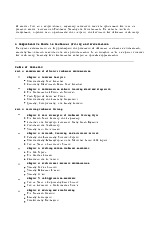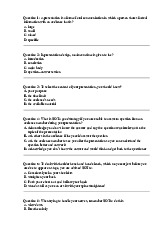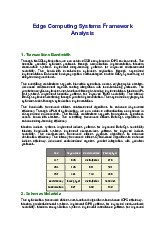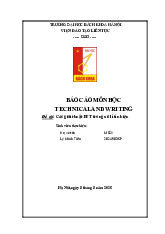



















Preview text:
I. Multi-Choice questions (6 points):
Question 1: A presentation is a form of oral communication in which a person shares factual
information with an audience that is …
A. large B. small C. mixed D. specific
Question 2: The three major elements of presentation do not include …
A. visual aids B. an audience C. a presenter D. specific content
Question 3: The audience for a presentation consists of people who …
A. are uniform in their level of information and purpose
B. vary in their level of information and purpose
C. are uninformed and lack a purpose
D. are confused in their purpose
Question 4: To make a presentation effective and impressive, you should use … A. passive sentences
B. a simple and active form of sentences C. jargon D. complex sentences
Question 5: Which of the following nonverbal cues can convey a lack of preparedness during a presentation?
A. Using appropriate hand gestures
B. Maintaining good eye contact with the audience
C. Speaking clearly and concisely
D. Fidgeting or appearing nervous
Question 6: What DO NOT charismatic people usually do in their presentation?
A. Slump when sitting or standing
B. Look at whoever they are talking to
C. To be slow in their movement, speech, breathing, blinking
D. Make gestures that are upwards and outwards toward the audience
Question 7: Which of the following activities should we do in non-verbal communication?
A. Do not focus on your audiences
B. Keep your gaze on the individual who you are speaking to, for 30% to 40% of one- onone conversations
C. Take down any obstacles in the way of you and your audience
D. Keep eye contact with everyone in the room evenly during big groups
Question 8: Which of the following nonverbal cues can help manage audience reactions during a presentation?
A. Maintaining good eye contact with the audience
B. Using hand gestures to emphasize key points C. Dressing professionally
D. Pausing and adjusting presentation pace in response to audience cues
Question 9: While giving your presentation, how might you improve the way you are speaking?
A. By varying your pitch and volume to emphasize certain parts of the speech
B. By talking quickly so people feel pumped C. Using jargon
D. Directing your voice primarily at those sat near the front
Question 10: What is the characteristic of pacing in communication?
A. Slow down your speed by pausing
B. Organize words into phrases based on their meaning and stop in between each phrase
C. The most crucial portions should be made slowly D. All of the options
Question 11: In selecting presentation technologies, it is important to select technologies that are?
A. Available and can be used at the presentation location
B. The state-of-the-art in presentation technologies
C. Freely available to download and use
D. Commonly used by presenters
Question 12: Generally there are no more than … colors on one slide? A. 1 B. 2 C. 3 D. 4
Question 13: In a scientific paper, what part is the answer to the research question?
A. Introduction B. Method C. Result D. Discussion
Question 14: Which of the following concepts that refers to the overall understandability of
what you write or say and involves summarizing the overall argument; putting separate, major
points into separate paragraphs; and beginning each paragraph with a ‘topic
sentence’,following by supporting sentences?
A. Organization B. Coherence C. Cohesion D. Writing Conventions
Question 15: What can you do to make your writing clear?
A. Joining sentences by omitting a repeated subject
B. Using several kinds of conjunctions
C. Using semicolons to maintain two closely linked concepts in a single sentence D. All of the options
Question 16: Which of the following sentences is punctuated incorrectly?
A. An experienced desert guide led our tour
B. A young, efficient, kind nurse took care of her
C. The players arrived in the morning, they gathered on the field D. None of the options
Question 17: Which of the following is NOT a reason why proofreading is a writer's final step in document preparation?
A. Proofreading is the responsibility of the manager, not the writer
B. Proofreading detects easily correctable sentence-level errors
C. Proofreading improves the effectiveness of an engaging and informative document
D. Basic errors distract the reader
Question 18: Which includes the most proper steps for paraphrasing?
A. Read it several times ->Note down the key concepts->Write your own
version>Compare the text->Cite the source B.
Cite the source->Read it several times->Note down the key concepts->Write your own version->Compare the text C.
Read it several times->Compare the text->Cite the source ->Note down the key
concepts->Write your own version D.
Note down the key concepts->Write your own version->Read it several times ->
Compare the text->Cite the source
Question 19: Which of the following can certainly lead to plagiarism?
A. Presenting someone else's findings without a citation
B. Copying a substantial amount of text from past publications without using quotation marks
C. Repeating one's own previously published findings without a citation
D. Presenting someone else's findings with appropriate citations Question 20: What should
you do in the literature review? A.
Always read the papers in the literature review deeply B. B. Look over it quickly to determine whether a paper is C. relevant D. C. Read the papers in the literature review carelessly E. D. All of the options F. G. Question 21: What can you do to find the research papers? H. A. Explore the Web using obvious search keywords I. B. Searching on digital libraries such as Wiley, ACM J. and so on
K. C. Investigate the references mentioned in promising L. research papers M. D. All above statements N. Question 22: Before attempting to paraphrase, read the
O. original text multiple times to ensure that you understand all P. these EXCEPT for: Q. A. The main points R. B. The structure S. C. The context T. D. The visual aids U. V. Question 23: What do you need to do in order to develop a W. good literature review? X. A. Assemble papers based on subject and contribution Y. B. Add notes to each paper Z. C. Choose whether to include each article you read to AA. the literature review BB.D. All above statements CC. DD. Question 24: Contribution is the main criterion for judging a EE. paper. Typically, a paper is a contribution if it has two main FF. properties? GG. A. Methodology and result
HH. B. Review and open question
II. C. Originality and validity JJ. D. Proposal and result KK. LL. Question 25: Smallest sections of a technical reports MM. included? NN. A. introduction OO. B. discussion PP. C. abstract QQ. D. All of above RR. SS. Question 26: When you write the first draft of a technical TT. report, which of the following parts should be written first? UU. A. The abstract VV. B. The conclusion WW. C. The introduction XX. D. The main text YY. ZZ. Question 27: Both introduction and conclusion AAA. A. Should approximately be 10% of the overall report
BBB. B. Provides a clear answer to any question asked in the CCC. title, as well as summarizing the main points DDD. C. Explains the purpose and scope of the paper to the EEE. reader
FFF. D. Includes suggestion for future research GGG. HHH. Question 28: Which question is not relevant to an experiment III. mentioned in a technical report? JJJ. A. What outcome do you expect?
KKK. B. Will successful results confirm an effective LLL. sponsorship? MMM. C. What resources should be measured ? NNN. D. What are appropriate sources of test data? OOO.
PPP. Question 29: Sincerely, is an example of a...? QQQ. A. Closing Line RRR. B. Signature Line SSS. C. Complimentary Closing TTT. D. Complimentary Line UUU. VVV. Question 30: Which of the following is the ideal format for a WWW. modern CV? XXX. A. Clean and simple YYY. B. Elaborate and fancy ZZZ. C. Colorful and nice layout AAAA. D. All of the options BBBB. B. Look over it quickly to determine whether a paper is CCCC. relevant DDDD. C. Read the
papers in the literature review carelessly EEEE.D. All of the options FFFF. GGGG. Question 21: What can you do to find the research papers? HHHH. A. Explore the Web using obvious search keywords IIII.B. Searching on digital libraries such as Wiley, ACM JJJJ. and so on KKKK. C. Investigate the references mentioned in promising LLLL.research papers MMMM.D. All above statements NNNN. Question 22: Before
attempting to paraphrase, read the OOOO. original text multiple times to ensure that you understand all PPPP. these EXCEPT for: QQQQ. A. The main points RRRR. B. The structure SSSS. C. The context TTTT.D. The visual aids UUUU. VVVV. Question 23: What do you need to do in order to develop a WWWW. good literature review? XXXX. A. Assemble papers based on subject and contribution YYYY. B. Add notes to each paper ZZZZ.C. Choose whether to include each article you read to AAAAA.the literature review
BBBBB. D. All above statements CCCCC. DDDDD.Question 24: Contribution is the main criterion for judging a EEEEE. paper. Typically, a paper is a contribution if it has two main FFFFF. properties? GGGGG.A. Methodology and result HHHHH.B. Review and open question
IIIII. C. Originality and validity JJJJJ. D. Proposal and result KKKKK. LLLLL. Question 25: Smallest sections of a technical reports MMMMM. included? NNNNN.A. introduction OOOOO.B. discussion PPPPP. C. abstract QQQQQ.D. All of above RRRRR. SSSSS. Question 26: When you write the first draft of a technical TTTTT. report, which of the following parts should be written first? UUUUU.A. The abstract VVVVV.B. The conclusion WWWWW.C. The introduction XXXXX.D. The main text YYYYY. ZZZZZ. Question 27: Both introduction and conclusion AAAAAA. A. Should approximately be 10% of the overall report BBBBBB. B. Provides a clear
answer to any question asked in the CCCCCC. title, as well as summarizing the main points DDDDDD. C. Explains the purpose and scope of the paper to the EEEEEE.reader
FFFFFF. D. Includes suggestion for future research GGGGGG. HHHHHH. Question 28: Which
question is not relevant to an experiment
IIIIII. mentioned in a technical report?
JJJJJJ. A. What outcome do you expect? KKKKKK. B. Will successful results confirm an effective LLLLLL.sponsorship? MMMMMM. C. What resources should be measured ? NNNNNN. D. What are appropriate sources of test data? OOOOOO. PPPPPP. Question 29: Sincerely, is an example of a...? QQQQQQ. A. Closing Line RRRRRR. B. Signature Line SSSSSS. C. Complimentary Closing TTTTTT.D. Complimentary Line UUUUUU. VVVVVV. Question 30: Which of the following is the ideal format for a WWWWWW. modern CV? XXXXXX. A. Clean and simple YYYYYY. B. Elaborate and fancy ZZZZZZ.C. Colorful and nice layout AAAAAAA. D. All of the options B. Look over it quickly to determine whether a paper is relevant C. Read the papers in the
literature review carelessly D. All of the options
Question 21: What can you do to find the research papers?
A. Explore the Web using obvious
search keywords B. Searching on
digital libraries such as Wiley, ACM and so on C. Investigate the references mentioned in promising research papers D. All above
statements Question 22: Before
attempting to paraphrase, read the
original text multiple times to
ensure that you understand all



